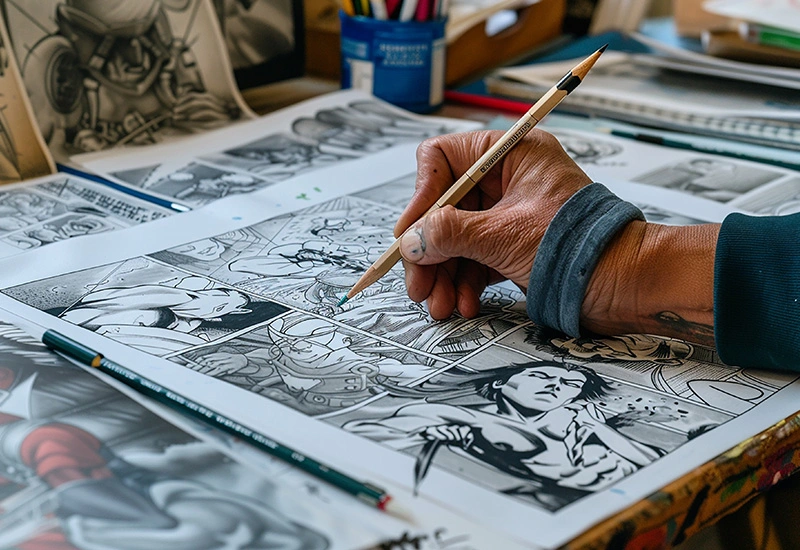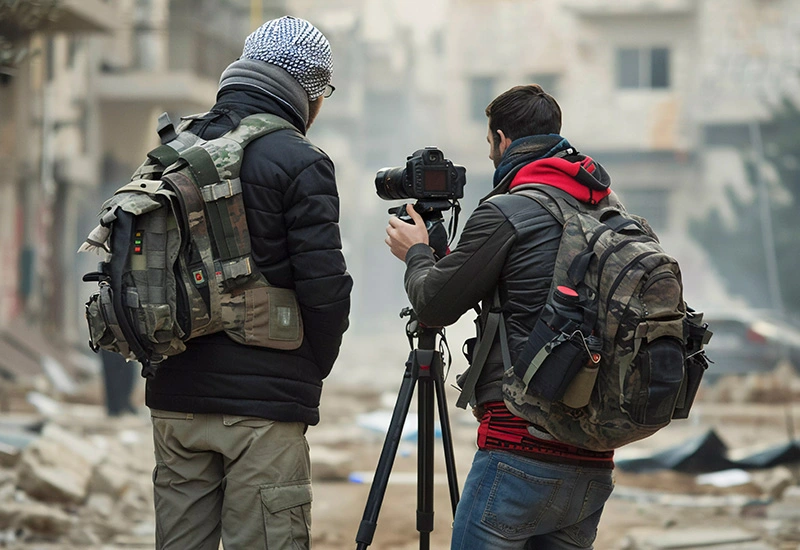The first step to any successful project is preparing a well-thought-out plan. For a video production project, pre-production is the first and most crucial step to take. If you’re new to the video or film-making process, having a video pre-production checklist not only helps you stay on track but also reminds you of all the important steps you absolutely should not miss/skip.
But, before we learn what items should be on your checklist, let’s get a clearer understanding of what video pre-production is.
What is pre-production?
Pre-production is basically the first phase in video production, in which you plan and coordinate every step of the shoot. Some tasks include preparation of the budget and schedule, choosing the cast and crew, scouting the location, preparing the storyboard, etc.
Pre-production may feel like an unnecessary step if your video project is small or if you aren’t fully invested in the success of the shoot. However, big projects (like big-budget movies) can suffer huge losses if there is even a small mistake. For example, your film might end up permanently shelved if you forget to buy the rights to use the source material.
Therefore, you should have a pre-production checklist ready, so don’t forget anything and stay on track.

Pre-production checklist
Since there are various types of videos, the pre-production checklist will vary accordingly. So, we will give you a general overview of what happens during this phase, which you will find in the majority of video projects.
1) Define your goals (purpose of the video)
For the success of any project, you need to be certain about why you are doing it. A purposeless video will end up being chaotic, expensive, and ineffective.
So, your first step should be to figure out why you are making the video and what you hope to achieve. Are you trying to persuade the viewers, inspire them, or entertain them? Or do you want to increase brand awareness, educate the audience, or showcase a product? When you have a purpose, you have an end goal with which you can compare your project’s effectiveness.
Having a goal also helps determine what kind of video you need to make – explainer videos, animated videos, promo videos, etc.
2) Get a script ready
Ideally, you’ll have a script ready before you plan a budget. With a script in hand, it’s far easier to identify and estimate all the resources you need. A script is basically a guide for everything that goes into the final video. It will contain the story, dialogue (if any), props, visual directions, and so on.
If you don’t have one, this is when you should start writing a script for better coordination. This is what everyone on the production team will be using to understand their roles and tasks.
3) Prepare the budget
To even begin thinking about the next step, you need to know how much money you need to finance your project. Sometimes, you may be allocated a fixed amount of funds to produce video content. Other times, you may have the freedom to propose an amount for approval. In any case, you need to know how much money you have at your disposal to start planning out a project.
Planning a budget beforehand is also preferable, as it will stop you from overspending.
4) Prepare your storyboard or shot list
A storyboard looks very similar to a comic book. There are panels with illustrations and notes on the board, each of which is a shot-by-shot representation of how the final video will look. The graphics visually detail how the camera will move, how a scene will be staged, and where the graphics, titles, etc., will go. The notes on the board describe the scene and what’s being said in it.

The storyboard is almost always based on the script and is used by crew members to understand what needs to be done.
Meanwhile, a shot list is far more detailed and contains technical information like camera movement, camera angles, lighting, camera lens types, etc.
5) Figure out your target audience
Another very important factor for a successful video project is the selection of your target audience. Knowing WHO you’re making the video for is just as important as knowing why you are making it. When you have finalized your target audience, you can tailor the message and select the distribution channel, time, cast, theme, and so on.
It’s always better to prepare the video content according to your audience since it improves your chances of success.
6) Determine how you want to distribute the video
Before shooting the video, you also need to decide the means of distribution. Is it to be released on social media, your website, YouTube, or in theaters? Each of these platforms has their own format, which is why you first need to determine the distribution channel.
When you know where it will be played, you can decide the different technical details, like video aspect ratio, frame rate, bitrate, etc.
7) Plan out what story you want to tell
A story/plot is not exclusive to movies or commercials. Every video needs to tell a story to convey your message effectively. What is also important is the way in which you narrate your story, what points you cover, and the flow of the overall video. Even if your message is as simple as “Try our product”, the story should be able to convince the viewer to consider your suggestion. However, all stories don’t have to be complicated or grand.
Some other messages could be:
- Letting the audience know that you are offering a unique solution
- Offering customer/client testimonials to showcase your product/service
- Spreading awareness of your brand values to generate goodwill
8) Identify and procure the necessary resources
Now, to shoot your video, you need resources like equipment, talent, time, location, funds, etc. Having all necessary resources identified and ready in the pre-production phase is the key to ensuring a smooth project flow. You won’t have to worry about avoidable surprises when you start filming.
9) Select the cast and crew
Based on your project and budget, you will have to select the cast to play the different roles. For some videos, you may not need actors (or anyone for that matter) to be present in the video. Sometimes, just a voiceover is enough, or even just text with music. If you are making a movie, short film, or commercial, you may need to hold auditions to find actors who are suitable for the role.
Furthermore, to make any other preparations or to coordinate efforts to begin production, you will need the help of a production crew. The various crew members who are part of the production crew are the producer, director, scriptwriter, cinematographer, and production designer and coordinator. You can also consider getting a video editor at this stage, but only if you absolutely need one. Video editors typically come into the picture in the post-production phase (after filming). However, you can hire them as consultants to decide on the practicality of shots and other aspects.
10) Location scouting (if necessary)
Sometimes, you may need to shoot your film at a different location. It could be in a studio, building, warehouse, garden, public park, or wherever else. In any case, to settle on a location, you need to go yourself or send someone (known as a location scout) to find you the location that meets all the criteria for your shoot.

For example, imagine that you want to shoot a commercial in a public park. Which location should you select? First of all, it should be a park, or, at the very least, it should have enough greenery to pass off as one. Secondly, the area should be well-lit since it’s an outdoor shoot. In such a case, you should also consider the weather. The next point of consideration is accessibility. Your equipment, cast, and crew should easily be able to get in and out of the area. You also need to consider your budget and decide if the place is worth the money being quoted. Lastly, get any required permissions before you start production so that there are no issues on the day of the shoot.
Sometimes you can make a video using a green screen or create a set and film there.
11) Create a schedule (for big video productions)
A schedule is just what it sounds like. It keeps you on track so you can finish the video project within the deadline. Schedules come in pretty handy as productions become more expensive the longer they take. Salaries, location rent, equipment rent, transport, and other expenses tend to add up the more time you use the resources.
Schedules should be framed with a reasonable timeframe so they do not become rushed or drag on for too long.
People involved in pre pre-production
| Director and/or assistant director | They are in charge of the entire production and their job is to ensure that the project goal/vision is met |
| Producer(s) | They manage the video production budget, schedule, and logistics |
| Scriptwriter | They write the script for the project and even help with making the storyboard |
| Cinematographer | They plan all the visual aspects of the shoot, including lighting and shot composition |
| Production designer | They are in charge of the set design, costumes, props, and the visual theme |
| Production coordinator(s) | The list of their duties includes setting up the production office, organizing the equipment, supplies, and staff, coordinating travel, accommodation, work permits, and visas for the cast and crew, and distributing shooting schedules, crew and cast lists, scripts, and script revisions. |
| Video editor (for larger projects) | For big-budget video productions, they are part of the pre-production phase as consultants. They help determine if the shots are practical, provide advice on post-production needs, etc. (More details are in the next section.) |
What role does a video editor play in the video pre-production phase?
As already mentioned, the role of a video editor will come into play in the post-production phase. They put together the various clips, graphics, audio, and other elements to make the final video. However, in larger production projects, it is not uncommon for video editors to be brought in to help out in different aspects. Here’s a brief list of how they can help:
- They can be brought in as consultants to give advice on what shots are feasible or challenging for the post-production team.
- They can guide the team when it comes to deciding on the special effects, transitions, and complexity of shots.
- They can suggest what shots and sequences will be easier to work with in the editing room.
- They can review scripts and storyboards to identify if there will be problems when editing. They can suggest changes, alternatives, or improvements to ensure that the flow goes hand-in-hand with the editing style.
- Video editors can also advise the team on technical aspects like aspect ratio, file formats, frame rates, etc. This will ensure that the video files are compatible with the software so the editing process goes smoothly.
- They also work with the director and cinematographer to plan shots that will liven up the final product. They can work together to finalize the camera angles, dramatic effects, etc.
- Editors can also offer input when the shot list is being prepared so that all the necessary angles and scenes are captured. This will help ensure that the editing process goes smoothly.
Final note:
Every step of a video production has to be pre-planned, regardless of the amount of money and resources involved. But it is even more pertinent when there is a lot riding on the success of the project. Many times, small mistakes can lead to the entire project being scrapped or shelved for a long time. That is why the pre-production phase is so important.
If you have a very small budget and want to work with a limited number of people for simple video projects, an experienced video editor will be able to help you navigate all the hurdles of video production.

